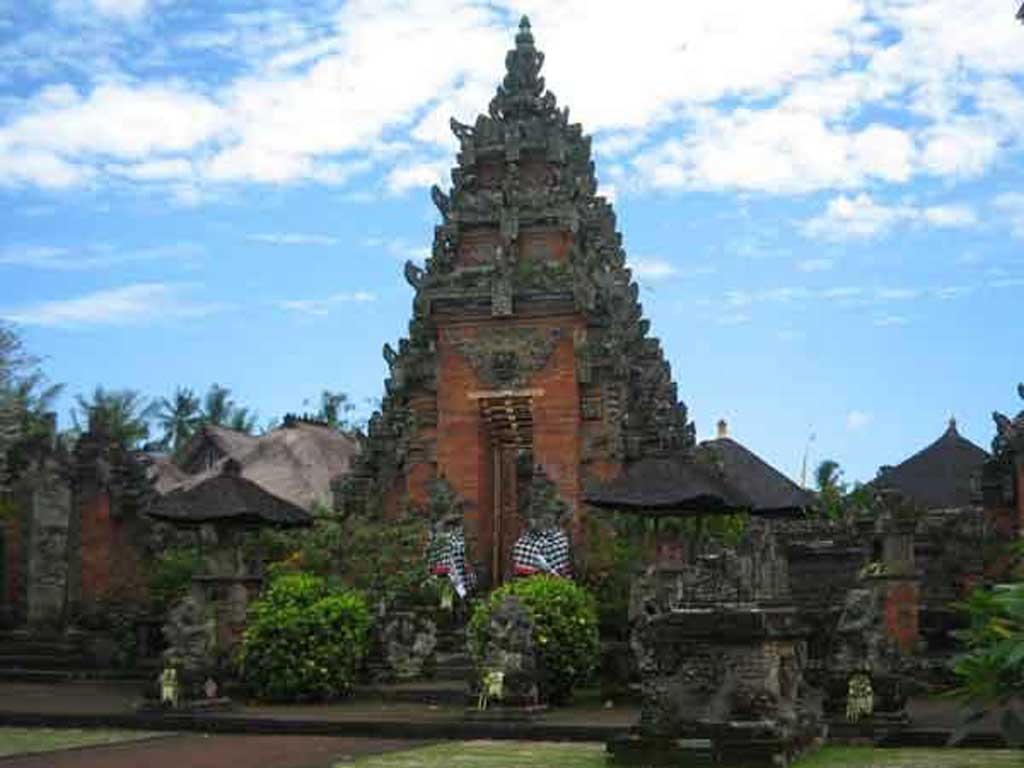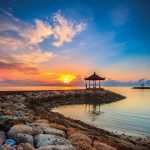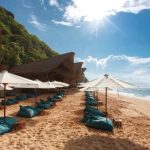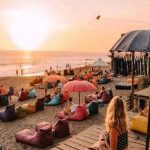Bali Tours : Denpasar
Denpasar, Bali, is well known to almost anyone who journeys to Indonesia’s famed and exotic tropical island. Denpasar is the principal entry and exit point for the island’s substantial international tourist industry. Denpasar is Bali’s capital city. Although the modern centre of government departments, international banks, and many other offices, it still retains its unique Balinese personality.
This is strongly felt and clearly seen in its many temples, universities and pleasant gardens, which still maintain their presence and influence. Denpasar has the Pura Jagatnatha, a temple dedicated to Bali’s Supreme God, Sang Hyang Widi. There are interesting statues of a turtle and two mystical dragons in the temple, signifying the foundation of the world.
The Pura’s awesome architecture resembles that of Balinese palace. It has now been converted into a museum housing a fine collection of prehistoric and modern art. The famous 4th century Pura Maospahit, is right next to Pura Jaganatha.
There is also an interesting place like; the government-supervised art centre, Sanggraha Kriya Hasta, which also home to a tremendous variety of handicraft and works of art. Taman Wedhi Budaya, meanwhile, is an arts centre with occasional exhibits of paintings, crafts and carvings, and holds traditional dances every evening. It is also the host of the annual Bali Arts Festival in June to July, with performances, exhibitions, art contest, and other activities of artistic nature.
The main street of Denpasar start with Gajah Mada Street in the west, Surapati Street in the centre, followed by Hayam Wuruk Street and ends as Raya Sanur Street in the east. There are many things of history and culture to see. The Puputan Square, with its heroic Catur Mukha, fondly commemorates the Balinese’s suicidal stand against the Dutch. Until today, it is touchingly, a popular meeting place for locals in the evenings.
1. Identification
Denpasar is the local capital of the Indonesian island of Bali. The population was 491,000 according to the official census in 2002. It is the only true city on the entire island, as all other urbanized areas are essentially heavily developed tourist districts or small towns. It is the major administrative and commercial center of the island.
2. International Airport
Ngurah Rai International Airport, just outside Denpasar, is the most important gateway for the island’s tourist industry. Many airlines service the airport in addition to Indonesia’s own Garuda. These include Air Asia, Cathay Pacific, Korean Air, Malaysia Airlines, Singapore Airlines, Qatar Airways and Thai Airways.
3. History
Denpasar’s standing as a capital dates back to the southern Balinese kingdom of Badung. The city was sacked and the royal palace razed as part of a Dutch invasion on the island in 1906.
4. Location and Tourism
Denpasar is located near the south-central coastal region of Bali. Some of the main tourist districts of Bali’s south-central coast are a 15-minute taxi ride to the southwest. These include the backpacker and surfer area in Kuta, and the upscale villas and resorts of Seminyak. Denpasar itself has little in the way of tourist attractions, and most visitors merely enter the city via the airport and then immediately move on
5. Climate
The climate in Denpasar is tropical, with temperatures ranging between average lows of 68 F and average highs of about 91 F. The dry season, between May and September, is usually the coolest and least humid in Denpasar, although that is also when there is little cloud cover and people are most exposed to the powerful near-equatorial sun. The monsoons, which are at their height between December and March, typically bring overcast skies marked by at least one heavy downpour every day. The monsoon months are also hotter and much more humid.
Conclusion About Denpasar
Once part of Badung Regency, in 1992 the Denpasar area split off and became Bali’s ninth kabupaten. In addition to the island’s capital, Denpasar Regency encompasses Sanur, Benoa Port, and Serangan Island, leaving Badung more pencil-shaped than ever. Denpasar is the largest and busiest city on the island.
An old trading center, its name means “east of the market.” It’s the headquarters for the government, the media, the island’s principal banks, airline offices, and hospitals. Bali’s two universities, Udayana and Warmadewa, are also based here. The city’s local name is Badung, its old name, and you’ll hear “Badung” sung out by bemo drivers all over Bali.
Although it’s been the capital of Bali since 1958, it’s no longer the administrative center of Badung Regency. In 1992, Greater Denpasar and Sanur split off from Badung and formed their own administrative entity – Denpasar. A hot, dusty, cacophonous, former Brahman-class city, Denpasar has grown fifteen-fold over the past 10 years and is now home to over 400,000 people. Its citizenry consists of Badung’s landed gentry, the priest class, and the new Balinese techno and bureaucratic elites, as well as Indonesians drawn from other islands to this economic magnet.
Denpasar is one of Indonesia’s most fully integrated and tolerant cities, with separate kampung of Bugis, Arabs, Indians, Chinese, Madurese, and Javanese. Without doubt it’s the richest, most important city in eastern Indonesia. Unless you’ve got business here, the city has few charms, other than those quiet back alleyways where people are quite friendly. The most important government offices are located in a tree-shaded administrative complex of handsome reddish brick and grey stone. Industry is low-tech and non-polluting. Denpasar is actually best at night, when it’s not so hot and the individual kampung resume their normal rhythms. It seems the whole population is either directly or indirectly involved in the tourist industry, and you can easily engage people in conversation.
Denpasar’s main one-way east-to-west shopping street, Jalan Gajah Mada, is crammed with chauffeured cars, noisy putt-putting bemo, roaring motorcycles, and smelly, spewing buses. The city’s limited attractions include a spacious alun-alun, tourist information offices, the island’s main bus stations, best-stocked markets, some good Chinese restaurants, a spirited night market, dance and drama academies, a major art center, a first-class museum and five big cinemas heralding the coming of the next kung fu epic.
Places of Interest
Bali Museum
The largest collection of Baliana in the world is located on the east side of Taman Puputan on Jl. Mayor Wishnu just south of the tourist office. The Bali Museum was established in 1910 by the conquering Dutch, who sought to collect and preserve artifacts they felt were disappearing overseas or succumbing to the elements. In 1917, an eruption of Gunung Batur and subsequent earthquakes destroyed hundreds of Denpasar’s buildings, including the museum. Rebuilt in 1925, it was used as a storehouse for artifacts and temporary exhibits until 1932, when it was established as an ethnographic museum. The German painter Walter Spies helped assemble many of its original treasures from private collections and donations.
The grand, well-kept complex consists of a series of attractive, grassy courtyards containing all the archetypes of Balinese architecture – bale agung, candi bentar, kulkul. The main structure, with its many pillars, is built in the manner of Puri Kanginan in the eastern regency of Karangasem. Standing next to it is a reproduction of Singaraja Palace on the north coast. With rich ornamentation both inside and out, the museum’s architecture combines the two principal edifices of Bali, the temple (pura) and the palace (puri). The museum’s four buildings contain a splendid collection of Balinese art, Neolithic stone implements, a hoard of Buddhist clay seals excavated near Pejeng, Balinese folk crafts, carved and painted woodwork, cricket-fighting cages, dance costumes, textiles, masks, weaving looms and fabrics, agricultural tools, musical instruments, furniture, scale models of ceremonial events, ethnographic exhibits.The first pavilion is a two-story building containing high-quality, early traditional, Kamasan-style paintings; classical Balinese calendars; modern Batuan and Ubud-style paintings; and work of the Academic and Young Artists (or Naive) schools. Another pavilion displays carved media—wood, stone, clay, and bone—including sculpted windows, doors, pillars, ceiling beams, friezes, old guardian figures, demons, and specimens of Bali’s extraordinarily earthy and vigorous folk art. The building, dedicated to prehistoric artifacts, displays Bronze Age implements, including the famous Gilimanuk bronze spearhead, the largest ever discovered in Southeast Asia. Also see ritual objects, priestly accoutrements, and a veranda lined with old stone statues. One building is devoted entirely to masks, weapons, and costumes of the performing arts, including rare barong pig masks and primitive dance masks from remote villages. There’s also an incredible display of topeng. A good part of the displays are annotated with English explanations, and clear maps in the central building show all the important prehistoric and historical sites of Bali. The museum also has a library and a shop selling postcards and books in English. However, there’s no ground plan of the museum nor is a guide available to show visitors around. Open Tues.-Thurs. 0800-1700, Friday 0800-1530, closed Monday.City’s Local Dining
Jl. Teuku Umar, which eventually joins Jl. Imam Bonjol, the road to Kuta, is a location of well-established warung, rumah makan, and restaurants serving Indonesian specialties at very reasonable prices. The city’s densest concentration of Indonesian-style eating establishments.
Kumbasari Shopping Complex, just off Jl. Gajah Mada by the river. Open 1800-2400. Dozens of stalls under plastic covers serve Chinese noodle soups, fried rice, sate, excellent martabak, babi guling, nasi campur, pangsit mie and chocolate donuts. Other pasar malam include the Kereneng bus station (the Asoka Night Market), serving excellent babi guling (only Rp4500) and other native dishes; opposite Tegal station (where you catch minivans to Kuta); and on Jl. Diponegoro near the Kertha Wijaya Shopping Center. All are good, cheap, entertaining night eateries that are so inexpensive only a glutton could possibly spend more than Rp.10,000.
Jagatnatha Temple
Just east of the big alun-alun on Jl. Mayor Wishnu, next to the museum, is a Hindu temple, Jagatnatha Temple, built in 1953. In the afternoon, people from the surrounding kampung come here to pray; the temple’s especially busy during the full moon. On a towered throne of white coral sits a bright, gold statue of Ida Batara Sanghyang Widhi in his typical pose. This is the supreme god of Balinese Hinduism. The padmasana rests on the back of the sacred turtle, clasped by two naga on plinths carved with scenes from the Mahabharata and Ramayana. The central courtyard is surrounded by a moat containing gigantic carp.Maospahit Temple
is an important temple for its a unique and archaeologically,located in a small alley in the middle of the city off Jl. Sutomo. Enter through a door in the alley. This temple, one of the oldest on Bali, has its origins in the great 14th and 15th century Javanese Majapahit Empire when Hinduism was first introduced to Bali. The massive statues of Batara Bayu and Garuda guard the split gateway. On the imposing facade is a pantheon of carved demons and deities, including Yama and Indra. Heavily damaged in the 1917 quake, the earliest, now-restored buildings are in the back. Look for the terra-cotta statues.Melanting Temple
In the midst of Pasar Badung, is a market temple where vendors make offerings on their way to their stalls. Pemecutan Palace (Puri Pemecutan) Puri Pemecutan near Tegal bus station on the corner of Jl. Thamrin and Jl. Hasannudin, built in 1907 to replace the original palace of the raja destroyed by Dutch artillery. Pemecutan, which shares the complex with Pemecutan Palace Hotel, houses old weapons and a renowned gamelan mas which survived from the original puri. Don’t miss the handsome, four-tiered kulkul diagonally opposite the palace with its eight small raksasa statues. Chinese porcelain plates decorate the topmost tier.
Puputan Square
A great place for families to hang out in the evenings is the huge, well-kept park in the middle of town, named for the bloody 1906 extermination of the island’s ruling class by the Dutch. An heroic-style monument facing Jl. Surapati commemorates this tragic event. Note the woman with the kris in one hand and jewels in the other. Eyewitnesses of the time reported that female members of the court tauntingly flung their jewelry at the Dutch troops before being mowed down by rifle fire. On every side of Taman Puputan are the traditional symbols of the power elite. North of the square is the Governor’s Residence, built in Javanese pendopo style. Facing the Bali Museum is the stolid, modern military headquarters complex. Just south of the square in the middle of the city’s busiest intersection is a five-meter-high, four-faced, eight-armed statue – Mukha, representing Batara Guru, “God of the Four Directions,” who is even-handedly blessing all the cardinal points simultaneously.
Sanur
Sanur area is the oldest tourism village in this area, where the first five star rated hotel was built. Its know for its luxurious and quiet area for tourists. It beautiful beaches and sun rise view make Sanur becomes one of the popular tourist destination in this world. Even you can see the memorable Le Mayur museum in its beach side.
STSI and SMKI
More advanced students attend Sekolah Tinggi Seni Indonesia (formerly ASTI), the Institute of Arts and Dance on Jl. Nusa Indah near the Art Center in Abiankapas. STSI director Made Bandem is responsible for a virtual renaissance in the Balinese arts. Tourism revenue is recycled into larger and grander ceremonies for the gods that, inevitably, include Balinese theater, music, song, and dance,
and thus contribute to the development and preservation of Balinese art.
SMKI is the Conservatory of Instrumental Arts and Dance for high school students in Batubulan. Opened in 1960; all Balinese dances are studied here. Visitors are welcome in the mornings to watch teachers train their pupils.
The Art Center
Also called Taman Werdi Budaya, the Art Center is on Jl. Nusa Indah in Abiankapas, a suburb of Denpasar in the direction of Sanur, only a 15-minute walk east of Kereneng station. Set in a restful garden with lotus ponds amid richly carved baroque Balinese buildings, the Taman Werdi Budaya houses exhibits of modern painting, masks, and woodcarving. Both Balinese and Indonesian artists are featured. You’ll find a car park, museum, and small, fixed-price handicraft shops. Visitors can view dance and music rehearsals in two open-air amphitheaters with modern lighting. Dances are also regularly staged for the public, including works incorporating modern Balinese choreography. In the kecak performance, staged each night 18:30-19:30 (Rp5000), traditional flickering oil lamps are still used. Eerie and powerful.
The Art Center also hosts a summer art festival each year from mid-June to mid-July, with competitions for costumes, dance, drama, sendratari performances, music, woodcarving, metalworking, and food. Every year is different, with each of Bali’s regencies sending its best teams. Also see art events, crafts exhibits, and an extravagant production of the Ramayana Ballet. If it’s the high season, be sure to book your hotel in advance. These entertaining and exciting cultural shows draw tens of thousands of visitors from around the world. The Balinese Art Development Center Program, Jl. Bayusuta (in the Art Center), is open 08:00-17:00 daily except Monday. This tertiary-level institute offers work on the undergraduate through master’s degree levels. Besides staging dances, plays, and pop concerts, it houses permanent exhibits offering handicrafts, paintings, carvings, and silver.





